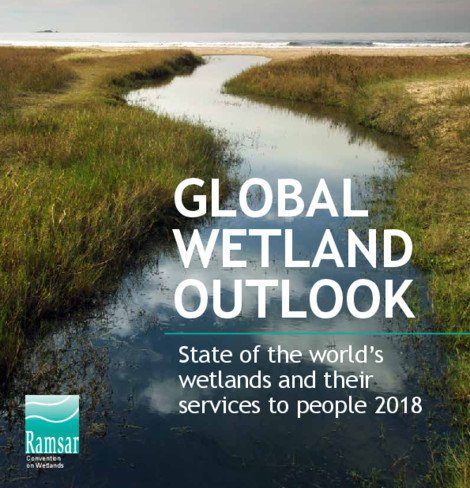Ahead of 13th Meeting of the Conference of the Parties (COP13) of the Ramsar Convention on Wetlands, the Parties have released a report on the state of the world’s wetlands, bringing attention to the rapid disappearance of these vital ecosystems.
Wetlands are disappearing three times faster than forests. Unabated, this trend will have severe consequences for the world warns the report. Approximately 35 per cent of the world’s wetlands were lost between 1970-2015 with annual rates of loss accelerating from 2000, according to this first-ever Global Wetland Outlook (GWO).
“The Global Wetland Outlook is a wake-up call – not only on the steep rate of loss of the world’s wetlands but also on the critical services they provide. Without them, the global agenda on sustainable development will not be achieved,” said Martha Rojas Urrego, secretary general of the Ramsar Convention on Wetlands.
The Ramsar Convention is a global treaty ratified by 170 countries to protect wetlands and promote their wise use and is the only international convention on wetlands. The report shows every region is affected. The report emphasizes the necessity of developing effective wetland management plans and integrating wetlands into the planning and implementation of national plans on sustainable development, climate change, and other key global commitments.
Land use policies that promote the conservation & sustainable use of #wetlands are a high priority to stop the current loss of the world’s #wetlands. New #GlobalWetlandOutlook states we are losing #wetlands 3X faster than forests. https://t.co/aL1C8niVHK @RamsarConv pic.twitter.com/REdvpvMuc7
— Martha Rojas Urrego (@martharojasu1) September 28, 2018
According to the UN, more than 80 per cent of wastewater is released into wetlands without adequate treatment, while fertilizer use in 2018 is likely to be 25 per cent higher than in 2008, exacerbating excessive wetland plant growth and levels of decomposition resulting in oxygen starvation for flora and fauna alike. While the biodiversity crisis is just as alarming, with more than 25 per cent of all wetlands plants and animals at risk of extinction.
“We need urgent collective action to reverse trends on wetland loss and degradation, and secure both the future of wetlands and our own at the same time,” said Rojas Urrego.
Drawing on successful examples across the world, the GWO report recommends using existing funding mechanisms to apply economic and financial incentives for communities and business to protect wetlands through tax benefits.
Other recommendations in the report include identifying solutions for wise use of wetlands that draw upon all expertise, ranging from hard science to traditional knowledge, to secure wide engagement on wetland protection and wise use and ensure sound decision-making.
ICYMI. New report released and we’re losing #wetlands (arguably THE most valuable habitat in the world) at a rate 3 TIMES that of forests. Need no just #ZeroWetlandLoss, but restoration asap. https://t.co/w2OilHaFLq
— ?? Alexis Morgan (@alexisjmorgan) September 27, 2018
“There is a slow awakening to the value of wetlands. Across the globe, legislative bodies need to integrate wetlands into policy programs and make investments into their sustainability,” said Rojas Urrego. “We need to educate the world on the critical importance of this most rapidly disappearing ecosystem. Without the world’s wetlands, we all hang in the balance.”
The Parties to the Ramsar Convention have committed to the conservation and wise use of all wetlands. The Parties have designated more than 2,300 sites of international importance so far, making the Ramsar List one of the world’s largest networks of protected areas. The GWO’s findings are expected to inform discussions and decisions at the Ramsar COP13, October 21–29th.









